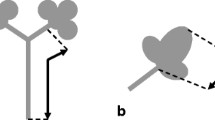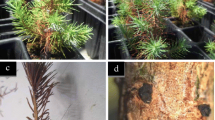Abstract
Two pineapple varieties differing in resistance to fusariose were examined for the phytotoxic effect of Fusarium subglutinans culture filtrate. The cultivars were Perolera (more resistant to pathovars of Fusarium subglutinans) and Smooth Cayenne (more susceptible). The phytotoxic effect of culture filtrate was assessed in tissue culture pineapple plantlets (by electrolyte leakage and placing the culture filtrate on wound leaf segments) and callus (inhibition of growth). Smooth Cayenne proved to be the most sensitive cultivar in each test, whereas Perolera showed resistance to the culture filtrate and its callus grew in the presence of high concentrations of culture filtrate that were completely toxic to Smooth Cayenne. These results show that plants can display cellular resistance to the culture filtrate.
Similar content being viewed by others
References
Arai, M. & M. Takeuchi, 1993. Influence of Fusariumwilt toxin(s) on carnation cell. Plant Cell Tissue and Organ Culture 34: 287- 293.
Baker, R.A., 1994. Soybean Sudden death Syndrome: Isolation and identification of a new phytotoxin from cultures of the causal agent Fusarium solani. (Abstr.) Phytopathology 84: p. 1144.
Batchvarova, R.B., V.S. Reddy, & J. Bennett, 1992. Cellular resistance in rice to Cercosporin, a toxin of Cercospora.Phytopathology 82 (6): 642-646.
Daquinta, M., A. Cisnero, Y. Rodriguez, M. Escalona, C. Perez, Y. Luna, & C.G. Borroto, 1996. Somatic embryogenesis in pineapple (Ananas comosus(L.) Merr). Pineapple News 2 (1): p. 12.
Daud, M.E., 1986. Tissue culture and the selection of resistance to pathogens. Annual Review Phytopathology 24: 159-186.
Dunkle, L.D. & T.J. Wolpert, 1981. Independence of milo disease symptoms and electrolyte leakage induced by the host-specific toxin from Periconia circinata. Physiological Plant Pathology 18: 315-323.
Durbin, R.D., 1981. Toxins in plant disease. Academic Press, New York.
Hartman-Mitchell C., T.R. Knows, & T.J. McCoy, 1983. Toxic components produced by Fusarium oxysporumf. sp. medicaginisand their use in alfalfa cell culture selection techniques. Phytopathology 73: p. 829.
Jin, H., G.L. Hartman, C.D. Nickell, & J.M. Widholm, 1996a. Characterisation and purification of a phytotoxin produced by Fusarium solani, the causal agent of Soybean Sudden Death Syndrome. Phytopathology 86 (3): 277-281.
Jin, H., G.L. Hartman, C.D. Nickell, & J.M. Widholm, 1996b. Phytotoxicity of culture filtrate from Fusarium solani, the causal agent of Soybean Sudden Death Syndrome. Plant Disease 80 (8): 922-927.
Kaur, G., U.S. Singh & G.K. Garg, 1987. Mode of action of toxin isolated from Fusarium oxysporumF. SP. ciceri. Indian Phytopathology 40 (1): 76-84.
Kern, H., 1972. Phytotoxins produced by Fusarium. In: R.K.S. Wood, A. Ballio, & A. Graniti (Eds) Phytotoxins in Plant Diseases, pp. 35-48. Academic Press, New York.
Kimati, H. & H. Tokeshi, 1964. Nota sobre a ocorrencia de Fusariumsp. causando resinose fungica em abacaxi. Revista da Agricultura 39: 131-133.
Lim, S.M., H.S. Song, & L.E. Gray, 1990. Phytotoxicity of culture filtrate from Fusarium solaniisolated from Soybean. (Abstr.). Phytopathology 80: 1044.
Matos, A.P., 1995. Pathological aspects of the pineapple crop with emphasis on the fusariose. Revista de la Facultad de Agronomía (Maracay) 21: 179-197.
Miller, R.J. & D.E. Koeppe, 1971. South corn leaf blight: Susceptible and resistant mitochondria. Science 173: 67-69.
Murashige, T. & F. Skoog, 1962. A revised medium for rapid growth and bioassays with tobacco tissue cultures. Plant Physiology 5: 473-498.
Pissarra, T.B., G.M. Chaves & J.A. Ventura, 1979. Sintomatologia da Fusariose (Fusarium moniliformeSheld f.sp. subglutinansWR. and RG.) durante o desenvolvimento vegetativo do abacaxizeiro. Fitopatologia Brasilera 4: 255-263.
Robbs, C.F., M. Amaral & J.C. Dianese, 1965. A 'resinose fungica' do Abacaxi (Ananas sativusSchulz) e sua ocurrencia nos Estados de Sao Paulo eMonas Gerais. In. Reuniao de Fitossanitaristas do Brasil, 9. Rio de Janeiro. Anais. p. 71.
SPSS/PC (Statistics Package for Social Science), 1992. User's Guide Version 4.0. Inc. Chicago.
Tomas, A. & W.W. Bockus, 1987. Cultivar-specific toxicity of culture filtrates of Pyrenophora triticif. sp. repentis. Phytopathology 77: 1337-1340.
Vidhyasekaran, P., E.S. Borromeo & T.W. Mew, 1986. Host-specific toxin production by Helminthosporium oryzae. Phytopathology 76: 261-266.
Wood, R.K.S., A. Ballio & A. Graniti, 1972. Phytotoxins in plant disease. Academic Press, New York.
Author information
Authors and Affiliations
Rights and permissions
About this article
Cite this article
Hidalgo, O.B., Pires de Matos, A., Cabral, R.S. et al. Phytotoxic effect of culture filtrate from Fusarium subglutinans the causal agent of fusariose of pineapple (Ananas comosus (L.) Merr. Euphytica 104, 73–77 (1998). https://doi.org/10.1023/A:1018387210157
Issue Date:
DOI: https://doi.org/10.1023/A:1018387210157




